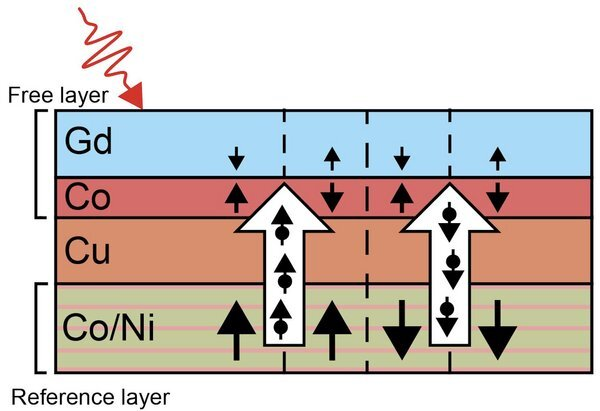Aug 3 2020
Today’s life is centered around data, implying that new, rapid, and energy-efficient techniques are required to write and read data on the storage devices.

Image Credit: Eindhoven University of Technology.
Optical-based methods, which involve using laser pulses rather than magnets to write data, have received a significant amount of interest in the past 10 years after the development of all-optical switching (AOS) intended for magnetic materials.
Although AOS is quick and energy-efficient, it is associated with precision problems. At the Eindhoven University of Technology (TU/e), scientists have now developed a new technique to precisely write data on a layer of cobalt-gadolinium (Co/Gd) with the help of a laser pulse, utilizing a ferromagnetic material as a reference point to assist with the writing procedure. The researchers’ study was published in the Nature Communications journal.
Magnetic materials integrated into various devices, including hard drives, store data in the form of computer bits—that is, 0s and 1s—in magnetic spins that are orientated either up or down. Conventionally, data is written to and read from a hard drive by shifting a tiny magnet across the material.
But with the growing demand for data production, storage, access, and consumption, there is a significant need for quicker and more energy-efficient techniques to access, record, and store information.
The Need for Deterministic Single-Pulse AOS
AOS of magnetic materials is a potential method in terms of energy efficiency and speed. AOS makes use of femtosecond laser pulses to change the orientation of magnetic spins at the picosecond level.
Data can be written by using a pair of mechanisms—single-pulse switching and multiple-pulse switching. The final spin orientation (that is, up or down) in multiple pulse switching is deterministic, which means it can already be established by the polarization of light.
But this kind of mechanism normally involves multiple lasers, which tend to slow the efficiency and speed of writing.
By contrast, a single pulse for writing would be relatively quicker; however, research works performed on single-pulse AOS demonstrate that switching is a toggle procedure. This implies that to modify the state of a particular magnetic bit, a prior understanding of the bit is required.
To put this in a simpler term, the state of the bit should be read initially prior to overwriting. This method introduces a read stage to the writing procedure and hence restricts speed.
A more improved technique would be a deterministic single-pulse AOS method, in which the ultimate direction of a bit relies only on the procedure used for setting and resetting the bit. Scientists from the Physics of Nanostructures team at TU/e’s Department of Applied Physics have now described a new method that is capable of achieving deterministic single-pulse writing in magnetic storage materials, rendering the writing procedure even more precise.
Importance of the Reference and Spacer Layers
The TU/e scientists developed a writing system for their experiments. This system contains three layers—a ferromagnetic reference layer created from nickel and cobalt that prevents or assists spin switching in the free layer, an optically switchable Co/Gd free layer, and a conductive copper (Cu) spacer or gap layer. The combined layers have a thickness of below 15 nm.
When the reference layer is stimulated by a femtosecond laser, it demagnetizes within a picosecond. Following this, some of the lost angular momentum related to the spins in the reference layer is subsequently transformed into a spin current transported by electrons. Within the current, the spins are aligned with the orientation of the spin in the reference layer.
Such a spin current subsequently shifts from the reference layer via the Cu spacer layer or gap layer and finally to the free layer, where it can prevent or assist spin switching in the free layer. This relies on the relative spin orientation of the free layer and the reference layer.
When laser energy is varied, it results in a couple of regimes. In the first regime, above one threshold, the final orientations of the spins in the free layer are fully established by the reference layer, and in the second regime, above a higher threshold, toggle switching is noted.
The scientists have demonstrated that both these regimes can be collectively used for precise writing of the spin states in the free layer without considering its initial state at the time of the writing procedure. This discovery presents a major advancement for boosting upcoming data storage devices.
Journal Reference:
Van Hees, Y. L. W., et al. (2020) Deterministic all-optical magnetization writing facilitated by non-local transfer of spin angular momentum. Nature Communications. doi.org/10.1038/s41467-020-17676-6.